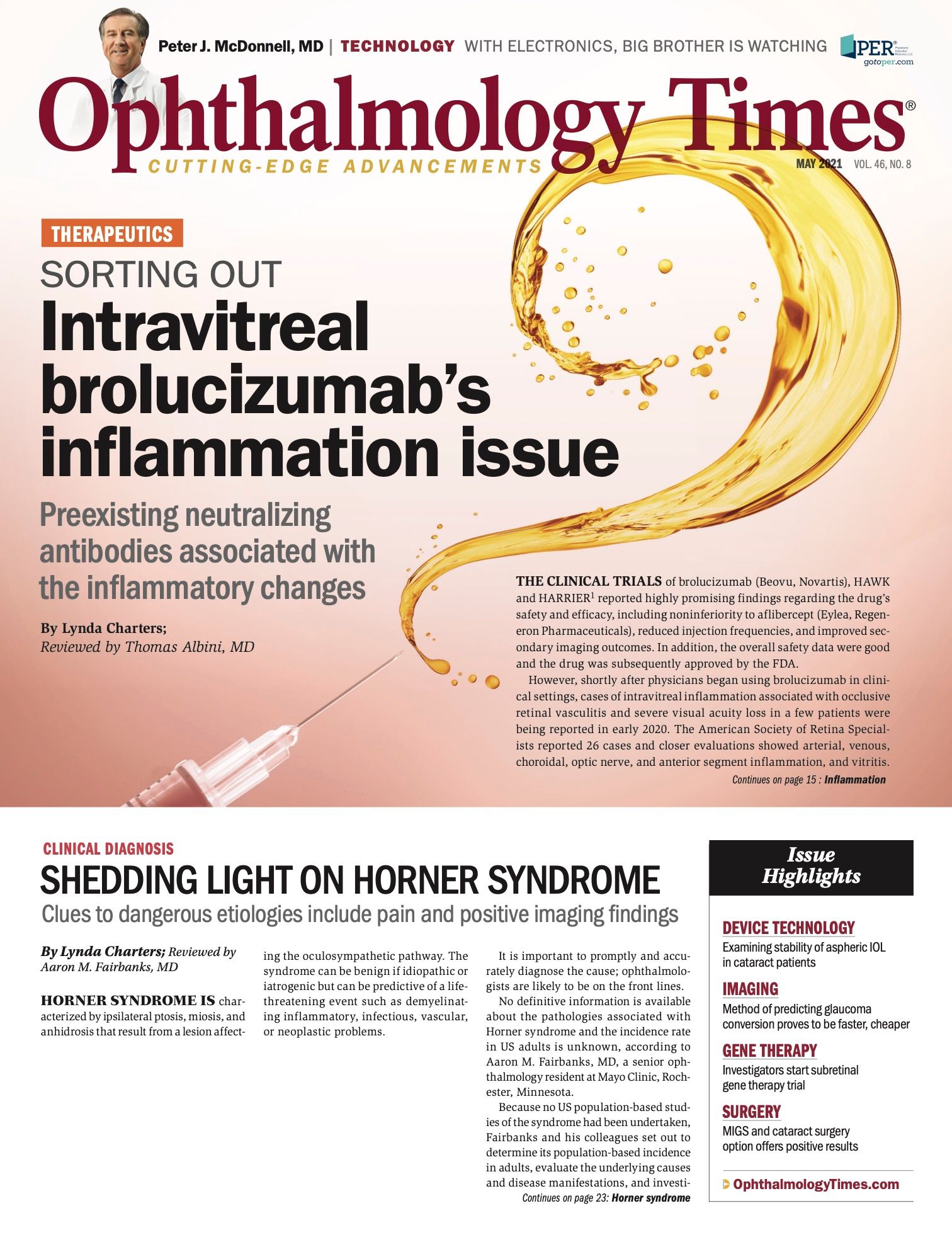Publication
Article
Digital Edition
Investigators start pivotal subretinal gene therapy trial
Author(s):
RGX-314 eyed by investigators as a therapeutic option for exudative AMD.

Reviewed by Allen C. Ho, MD
RGX-314 subretinal gene therapy (REGENXBIO Inc) is being tested in the first pivotal gene therapy trial for exudative age-related macular degeneration (AMD).
Interim results indicate the treatment is generally well tolerated with stable to improved visual acuity (VA) and reductions in anti–vascular endothelial growth factor (VEGF) injection burden of up to 1.5 to 3 years, depending on the cohort.
Related: The first steps in gene therapy for achromatopsia
Allen C. Ho, MD, a professor of ophthalmology at Wills Eye Hospital in Philadelphia, and Thomas Jefferson University in Plymouth Meeting, Pennsylvania, reported the findings.
RGX-314 uses an adeno-associated viral 8 vector to deliver a gene encoding for a therapeutic anti-VEGF Fab protein, and is designed to produce continuous anti-VEGF therapy, he explained.
Phase 1/2a first in human trial
A total of 42 patients have been enrolled in the RGX-314-001 study (NCT03066258) with up to 3 years of follow-up.
The drug continues to be well tolerated with stable to improved vision and has resulted in clinically meaningful decreases in anti-VEGF injections in cohorts 3, 4, and 5 of the 5 dosing cohorts, all of which were well balanced demographically.
The patients with neovascular AMD have been treated previously with an average of 10 injections annually for 4 to 5 years, and were required to respond to a baseline injection of ranibizumab (Lucentis; Genentech, Inc) before receiving RGX-314.
Related: Raising the retinal disease treatment bar with genetic testing
These patients do not receive systemic steroids during the study; anti-VEGF rescue injections were permitted beginning 4 weeks into the study if needed.
The primary outcome was determination of the safety and tolerability of RGX-314 through 6 months.
Secondary outcomes included determination of transgene protein production, effect on vision and ocular anatomy, and need for additional injections.
The retreatment criteria included the presence of any fluid, visual loss of 5 or more letters associated with fluid, and presence of hemorrhages.
“RGX-314 continues to be generally well tolerated across all doses,” Ho said. “Importantly, no clinically determined immune responses, drug-related ocular inflammation, or postsurgical inflammation were seen beyond what is expected following routine vitrectomy.”
Related: Gene therapy heralds new era for inherited retinal diseases
Surgical incision conjunctival hemorrhages and pigmentary changes in the retinal pigment epithelium (RPE) occurred, both of which were mostly mild events.
One patient had RPE changes through the macula that were associated with visual loss.
Ho presented interim data for cohorts 4 and 5 at 1.5 years and cohort 3 at up to 2 years.
An additional year of follow-up for cohort 3 is described below. Changes in best-corrected VA (BCVA) showed improved vision over 2 years for cohort 3, and this patient group had a significant reduction in the need for rescue therapy over the 2 years; in cohorts 4 and 5, the vision was stable or improved and the patients needed fewer rescue injections over a period of 1.5 years.
For cohorts 3, 4, and 5, retinal thickness was stable on optical coherence tomography images over time, and VA was stable or improved, including in those who did not need rescue therapy.
Related: Retinal therapeutic clinical trials address disease at core
Evaluation of the protein levels in cohorts 3, 4, and 5 showed durable and dose-dependent increases in protein production over 2 years for cohort 3, and over 1 year for cohorts 4 and 5.
Long-term follow-up study
This study will follow patients for an additional 3 years beyond the phase 1/2a trial, for a total of 5 years of follow-up after receiving RGX-314. Ho also presented the third year of data for cohort 3.
Thus far, investigators have reported no new drug-related ocular adverse events.
In cohort 3, patients continue to show stable to improved VA, and have shown a mean of 12 letters of improvement and a reduction in the need for rescue injections out to 3 years.
Related: Regeneration may help restore vision in inherited retinal dystrophies
Pivotal 2b/3 trial
Based on these findings, REGENXBIO has begun ATMOSPHERE, a subretinal pivotal trial in neovascular AMD.
Investigators will evaluate 2 doses of RGX-314 compared with monthly injections of ranibizumab in pseudophakic patients with a baseline VA of 20/32 to 20/160.
The study will enroll about 300 patients at 60 clinical sites. The primary end point is the mean change in BCVA relative to ranibizumab at week 54.
REGENXBIO is also conducting studies using the in-office SCS Microinjector to deliver RGX-314 to the suprachoroidal space in patients with neovascular AMD and diabetic retinopathy.
Upcoming results from these suprachoroidal programs will be announced for the phase 2 AAVIATE (neovascular AMD; NCT04514653) and ALTITUDE (diabetic retinopathy; NCT04567550) trials.
--
Allen C. Ho, MD
e:achomd@gmail.com
This article is adapted from Ho’s presentation at the Bascom Palmer Eye Institute Angiogenesis, Exudation and Degeneration 2021 virtual meeting. Ho reported
receiving research grants from REGENXBIO Inc, and he serves as a scientific advisor
to the company.

Newsletter
Don’t miss out—get Ophthalmology Times updates on the latest clinical advancements and expert interviews, straight to your inbox.





